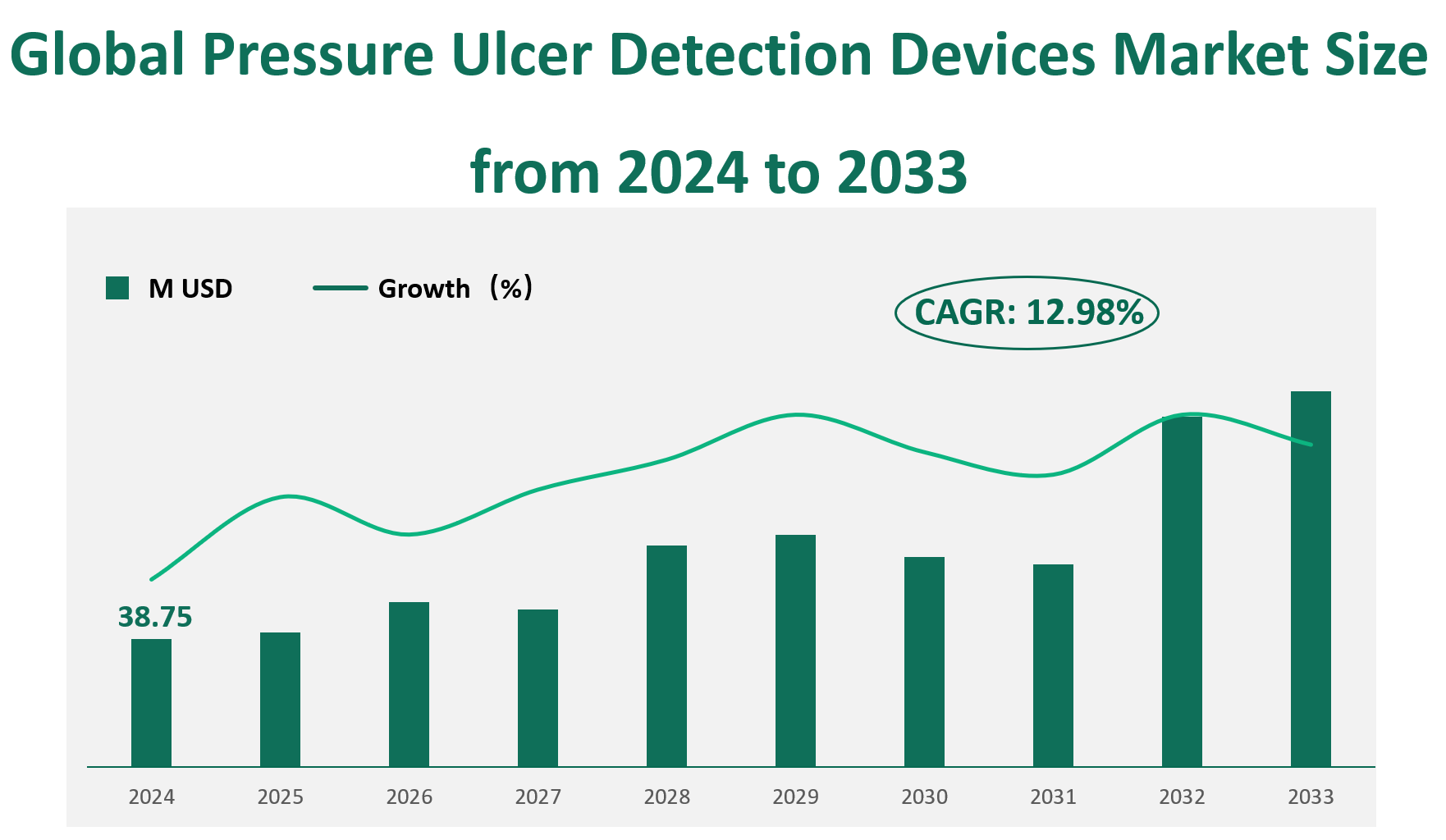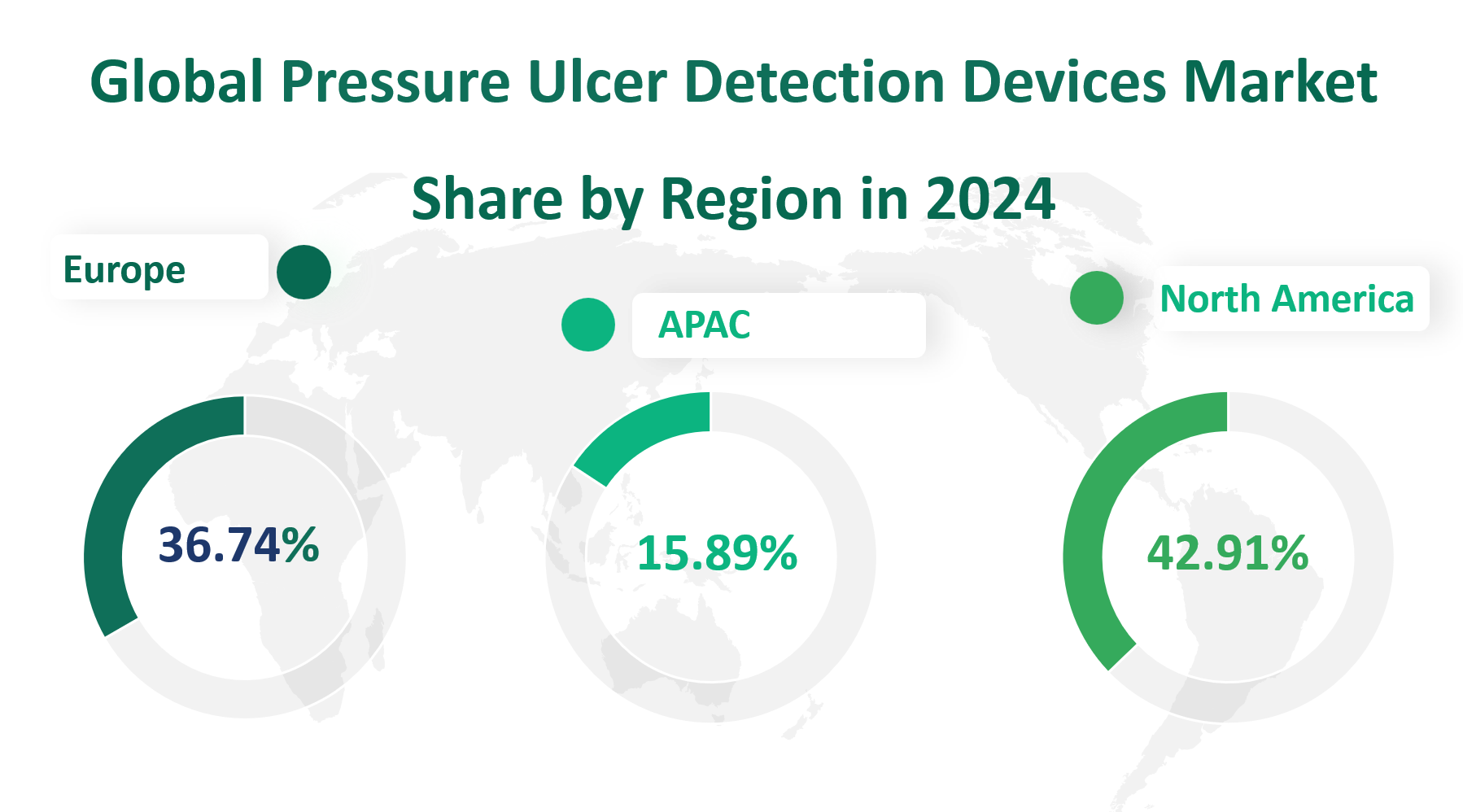1. Global Pressure Ulcer Detection Devices Market Revenue and Future Growth
The global Pressure Ulcer Detection Devices market is 38.75 million USD in 2024, with a robust Compound Annual Growth Rate (CAGR) of 12.98% from 2024 to 2033.
Pressure ulcers, also known as bedsores or decubitus ulcers, are localized injuries to the skin and/or underlying tissue usually over a bony prominence, as a result of pressure, or pressure in combination with shear and/or friction. A pressure ulcer detection device is a medical instrument designed to monitor and assess the risk of pressure ulcers in patients, particularly those with limited mobility or those confined to beds or wheelchairs for extended periods. These devices play a crucial role in early detection and prevention, leveraging advanced technologies to monitor pressure points and alert healthcare providers to potential issues.
Figure Global Pressure Ulcer Detection Devices Market Size (M USD) and CAGR (2024-2033)

2. Driving Factors and Limiting Factors of Pressure Ulcer Detection Devices Market
The growth of the Pressure Ulcer Detection Devices market is propelled by several key drivers. The increasing prevalence of chronic diseases and the aging population, particularly in developed regions, has heightened the need for effective pressure ulcer management. As individuals age, their skin becomes more fragile, and the risk of developing pressure ulcers increases. This demographic shift has led to a greater demand for preventive and monitoring solutions.
Additionally, the global healthcare industry’s focus on patient safety and quality of care has driven the adoption of advanced detection technologies. Hospitals and clinics are increasingly investing in these devices to reduce the incidence of pressure ulcers, which not only improves patient outcomes but also reduces the associated healthcare costs. Furthermore, technological innovations have made these devices more accessible and user-friendly, enabling their wider application in various healthcare settings, including home care.
Despite the positive growth outlook, the market faces certain challenges. High initial costs and the need for specialized training to operate advanced detection devices can be barriers to entry for some healthcare providers, particularly in resource-constrained settings. Additionally, the complexity of integrating these devices into existing healthcare systems and workflows may slow down their adoption. Regulatory requirements and the need for continuous updates to comply with safety standards also add to the operational complexities for manufacturers and users alike.
3. Technology Innovation and Corporate Mergers and Acquisitions in the Pressure Ulcer Detection Devices Market
Technological innovation is at the forefront of the Pressure Ulcer Detection Devices market, with continuous advancements aimed at improving device accuracy, ease of use, and connectivity. The integration of artificial intelligence and machine learning algorithms is enabling devices to predict pressure ulcer development with greater precision, allowing for timely interventions. Moreover, the rise of telemedicine and remote patient monitoring has opened new avenues for the application of these devices, facilitating continuous care and monitoring outside traditional healthcare settings.
Corporate mergers and acquisitions are also shaping the market landscape, with larger companies acquiring innovative startups to expand their product portfolios and gain a competitive edge. For instance, the acquisition of Leaf Healthcare by Smith+Nephew in 2019 is a testament to the strategic importance of such moves in consolidating market positions and driving innovation. These dynamics are expected to further fuel market growth and enhance the quality and range of products available to healthcare providers and patients.
4. Global Pressure Ulcer Detection Devices Market by Types
The global pressure ulcer detection devices market is segmented into three primary product types: Capacitive Based Pressure Sensor Pressure Ulcer Detection Devices, Monitor Alert Protect System Pressure Ulcer Detection Devices, and Others.
Capacitive Based devices utilize capacitive sensors to detect pressure changes, providing real-time data on pressure distribution. They are particularly useful in clinical settings where precise monitoring is required. In 2024, the market value for these devices is projected to be $17.83 million. The growth rate for this segment is steady, with a compound annual growth rate (CAGR) of approximately 10.57% from 2024 to 2033.
Monitor Alert Protect System are designed to monitor patient movement and alert caregivers when repositioning is necessary to prevent pressure ulcers. They offer a comprehensive solution that includes both monitoring and alerting features. In 2024, the market value for this segment is expected to reach $17.00 million.
Table Global Pressure Ulcer Detection Devices Market Size by Type in 2024
Type | Market Size (M USD) 2024 | Market Share |
Capacitive Based Pressure Sensor Pressure Ulcer Detection Devices | 17.83 | 46.01% |
Monitor Alert Protect System Pressure Ulcer Detection Devices | 17.00 | 43.88% |
Others | 3.92 | 10.11% |
5. Global Pressure Ulcer Detection Devices Market by Applications
Hospitals are the primary application area for pressure ulcer detection devices, given the high risk of patients developing pressure ulcers due to prolonged bed rest and limited mobility. In 2024, the market consumption for hospitals is projected to be 14,797 units. Hospitals account for the largest market share, with 51.38% of the total market consumption in 2024.
Clinics also utilize pressure ulcer detection devices, albeit on a smaller scale compared to hospitals. In 2024, the market consumption for clinics is expected to be 9,313 units. Clinics hold a significant market share of 32.34% in 2024.
Home care settings represent a growing application area for pressure ulcer detection devices, as more patients require long-term care at home. In 2024, the market consumption for home care settings is estimated at 4,689 units. This application has the smallest market share, with 16.28% of the total market consumption in 2024.
Table Global Pressure Ulcer Detection Devices Market Size by Application in 2024
Application | Market Size (Units) 2024 | Market Share |
Hospital | 14797 | 51.38% |
Clinic | 9313 | 32.34% |
Home Care Settings | 4689 | 16.28% |
Total | 28800 | 100.00% |
6. Global Pressure Ulcer Detection Devices Market Size by Region
North America, comprising the United States, Canada, and Mexico, is a leading region in the consumption of pressure ulcer detection devices. In 2024, the region is projected to consume 12,359 units. This region has a well-developed healthcare system and a high demand for advanced medical technologies. The growth rate for North America is expected to be 13.18% from 2024 to 2033, driven by continuous investments in healthcare infrastructure and the increasing prevalence of chronic conditions that require long-term care.
Europe is another significant region in the market, with a consumption of 10,581 units expected in 2024. European countries have a strong emphasis on healthcare and patient safety, which drives the demand for pressure ulcer detection devices. The growth rate for Europe is slightly lower than North America, with a CAGR of 11.17% from 2024 to 2033.
The Asia-Pacific region is the fastest-growing market for pressure ulcer detection devices, with a consumption of 4,577 units expected in 2024. The growth rate for the Asia-Pacific region is the highest among all regions, with a CAGR of 13.41% from 2024 to 2033.
The Middle East and Africa region is expected to consume 578 units in 2024. The growth rate for this region is 12.85% from 2024 to 2033.
South America, with Brazil as the leading market, is expected to consume 705 units in 2024. The growth rate for South America is 12.70% from 2024 to 2033.
Figure Global Pressure Ulcer Detection Devices Market Share by Region in 2024

7. Global Pressure Ulcer Detection Devices Market Analysis by Major Players
7.1 Bruin Biometrics
Introduction and Business Overview: Bruin Biometrics, established in 2009, is a leading company in biometric-sensor based medical devices. The company is dedicated to developing point-of-care solutions for the early identification and monitoring of chronic, preventable conditions. Its products are primarily sold in North America and Europe, where there is a high demand for advanced medical devices.
Products: The company’s flagship product is the Provizio SEM Scanner, a wireless handheld device used as an adjunct to the standard of care when assessing patients at increased risk for pressure ulcers. This device provides healthcare professionals with a tool to monitor and assess the risk of pressure ulcers more effectively.
Sales Revenue in 2021: In 2021, Bruin Biometrics reported a revenue of $10.45 million USD.
7.2 Wellsense
Introduction and Business Overview: Wellsense, founded in 2009, is a company that develops and manufactures medical devices focused on pressure injury prevention technology. The company’s products are designed to provide healthcare facilities with advanced solutions to prevent and manage pressure ulcers.
Products: Wellsense’s VŪ is an Advanced Pressure Visualization System™ (APVS) that offers real-time pressure imaging and evaluative feedback to improve clinician effectiveness and efficiency. The system is compatible with various support surfaces and provides detailed reports to enhance clinical decision-making.
Sales Revenue in 2021: The company’s revenue in 2021 was $4.76 million USD.
7.3 Leaf Healthcare, Inc
Introduction and Business Overview: Leaf Healthcare, Inc, established in 2010, is a medical device company specializing in ulcer prevention, wireless patient monitoring, and wireless mesh networks. The company was acquired by Smith+Nephew in 2019, which has further expanded its market reach and product capabilities.
Products: The LEAF Patient Monitoring System is a key product that wirelessly monitors a patient’s position and movement to automate and document the management of prescribed turn protocols for patients at risk for Hospital Acquired Pressure Ulcers (HAPUs). This system includes a wearable Patient Sensor, a wireless network of antennas, and proprietary software for data management and care alerts.
Sales Revenue in 2021: In 2021, Leaf Healthcare, Inc reported a revenue of $3.14 million USD.

